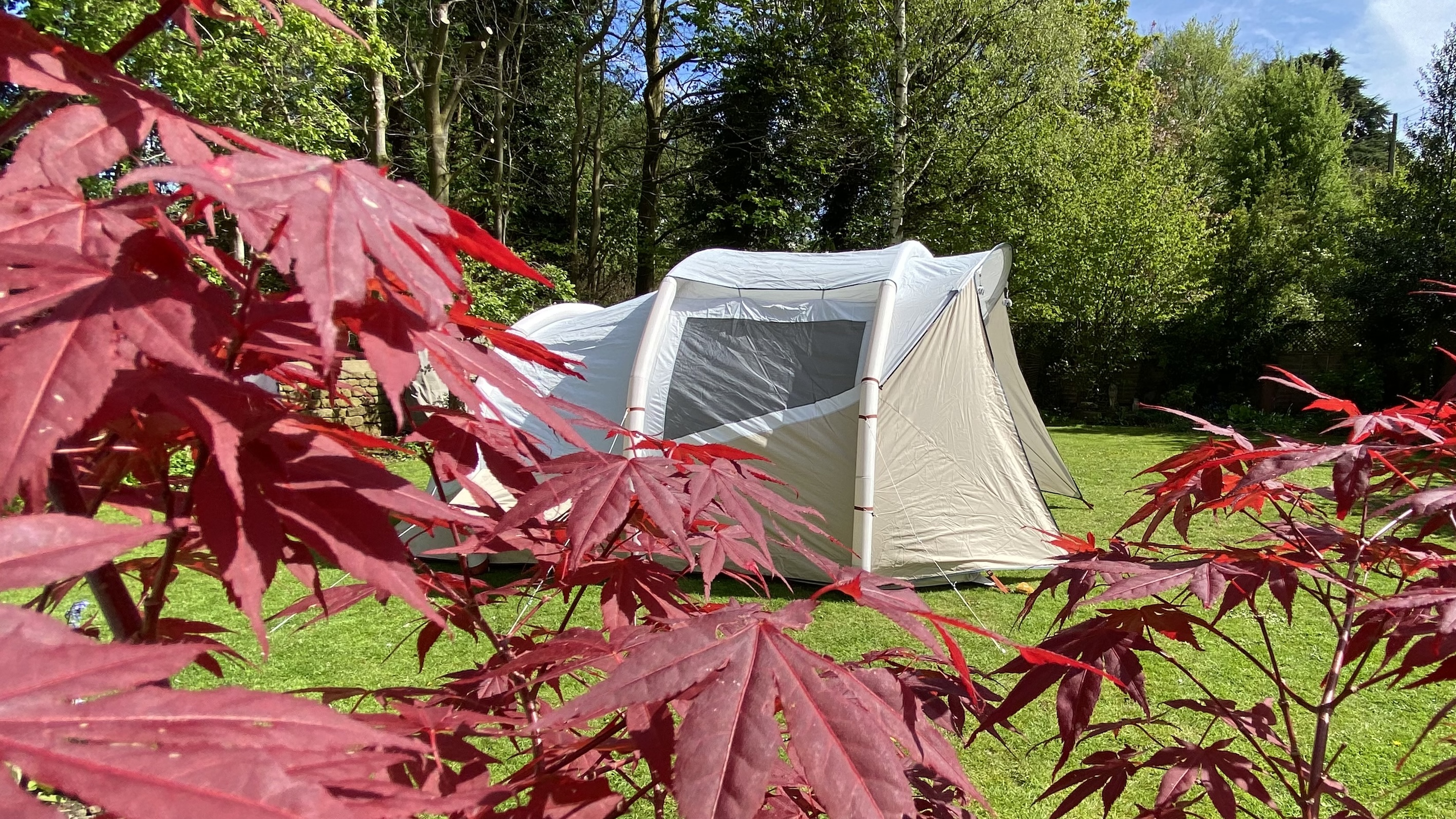
Welcome to our review of the Quechua Air Seconds 5.2 Fresh & Black, a cavernous five-person air tent from the house of Decathlon.
Quechua has fast become one of Europe's most respected and ubiquitous camping gear brands. As a result, its products are regularly seen at campsites across the UK and France.
Most of Quechua’s staff are avid campers themselves, and the company has feedback partnerships with experts in the field of outdoor adventure, including hikers and mountain guides. The result is a range of exceedingly well-designed outdoor equipment that is not only practical but durable, too.
I’ve reviewed numerous tents over the years but have never really found what I consider to be the Holy Grail of two-season family tents – until now. In fact, if ever there was a model richly deserved a high rank in our guide to the best tents, this is it.
There are so many reasons why the feature-rich Quechua Air Seconds 5.2 Fresh & Black is such a stand-out model for your next camping trip, so let’s get on with the review.
Decathlon Quechua Air Seconds 5.2 Fresh & Black review
Price and availability
Quechua is an in-house brand of Decathlon, along with its smaller Forclaz trekking tent range. As a consequence, the Quechua Air Seconds 5.2 Fresh & Black is only available direct from Decathlon, priced at a not unreasonable £569.99.
However, if this five-person model is too large for your needs and you require a smaller four-person version with single bedroom, check out this tent’s similarly-styled sibling, the Quechua Inflatable Air Seconds 4.1 F&B, which retails at £349 and is available from both Decathlon and Argos.
Specs at a glance
- Weight: 21.8kgs
- Footprint with guys: 6.6 x 4.65m
- Exterior: L - 5.6m; W - 3.65m; H - 2.1m
- Interior (lounge): L - 2.3m; W - 3.65m; H - 2.1m
- Interior (2 x bedrooms): L - 2.1m; W - 3.5m; H - 1.85m
- Combined living area: 31 square metres
Choosing tent size
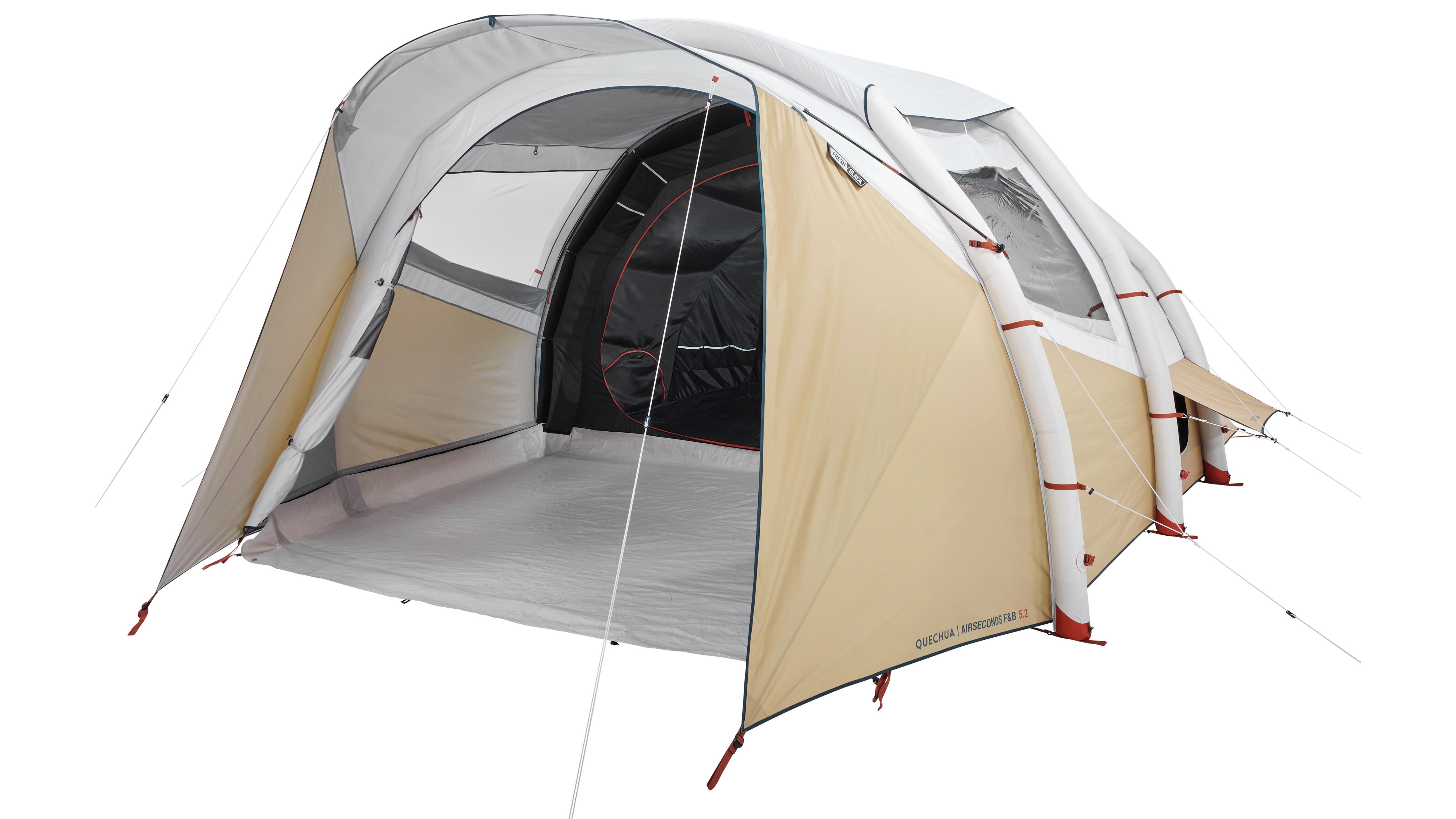
When it comes to choosing tent size, I always go for a model that’s advertised at roughly twice the occupancy or larger. Hence a two-or-three person tent for one, a four-to-five person tent for two and so on and so forth. We’re talking leisure-style car-camping here so why skimp on space when you can enjoy the freedom of movement and extra headroom that only the largest tents can provide? Yes, a larger tent will take up more car space but, believe me, you’ll appreciate the decision to go large the moment you pitch it and walk inside.
The Quechua Air Seconds 5.2 is designed for five people – three in one bedroom and two in the other. If used as a family tent, I would recommend keeping occupancy to two adults and a single teenager or two smaller children. In my case, the Air Seconds will be used for my just wife and I in the master room and our two labradors in the other, for whom only the best in comfort will do.
Pitching
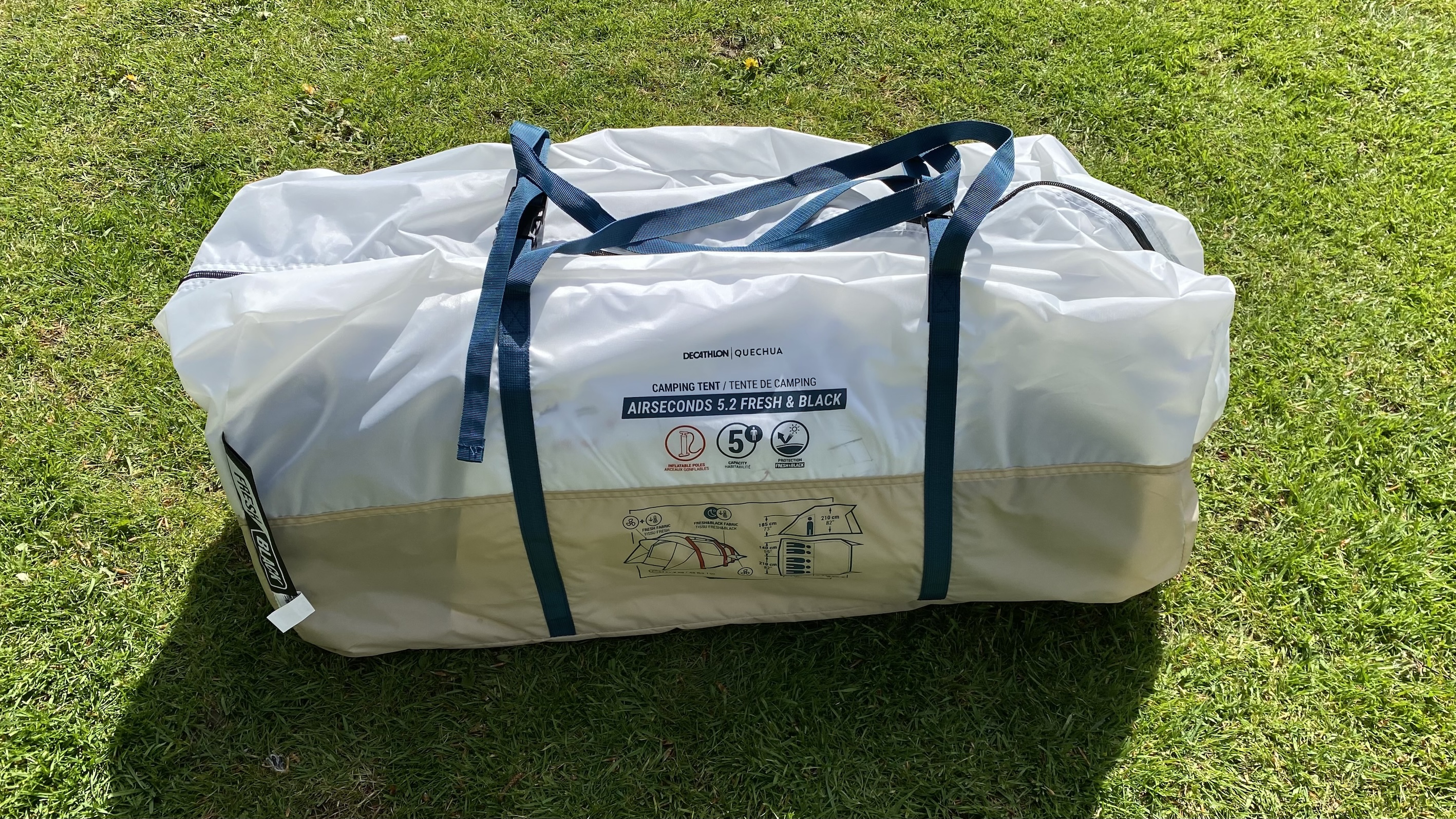
If you’re looking for a large family tent that’s a cinch to pitch, step right this way. In fact, I can’t think of any tent – both small or large – that has been so easy and effortless to erect. Mind, the sheer volume of this model does require a second person to help raise the air beams and loosen any kinks or the pump may come to a grinding halt and possibly even pop off the filler cap.
The very first thing to do is unfold it into your preferred orientation and peg down all four corners, especially if pitching in a strong breeze. Each one of the Air Seconds’ beams requires 7psi of pressure so you will need to purchase a good-quality hand pump to perform the task.
Most air tents tend to ship with a pump in the package but, for some reason, this one doesn’t so don’t forget to add a pump at checkout! For our test, Decathlon sent us its high-end Ultim Comfort 10 PSI (retailer link) hand pump and I can’t recommend it enough because, a) it inflates on the up-stroke as well as the down-stroke and b) it loads in a lot of air with each thrust. £25 well spent in my opinion.
Once the three air beams are inflated you will immediately see the form of the tent start to take shape. Then it’s just a case of adding a single pole for the front awning and pegging down the numerous guy lines. For extra interior rigidity, Quechua also provides an extendable aluminium strut for the lounge ceiling. However, the tent in this area is so tall – an impressive 2.1 metres – that those of shorter stature may need a box to stand on.
It took me about 17 minutes in total to pitch the Quechua Air Seconds 5.2 – seven minutes for the air beams and extra struts and 10 minutes for the many guy ropes. That’s impressively quick for a tent of such large dimensions.
Design
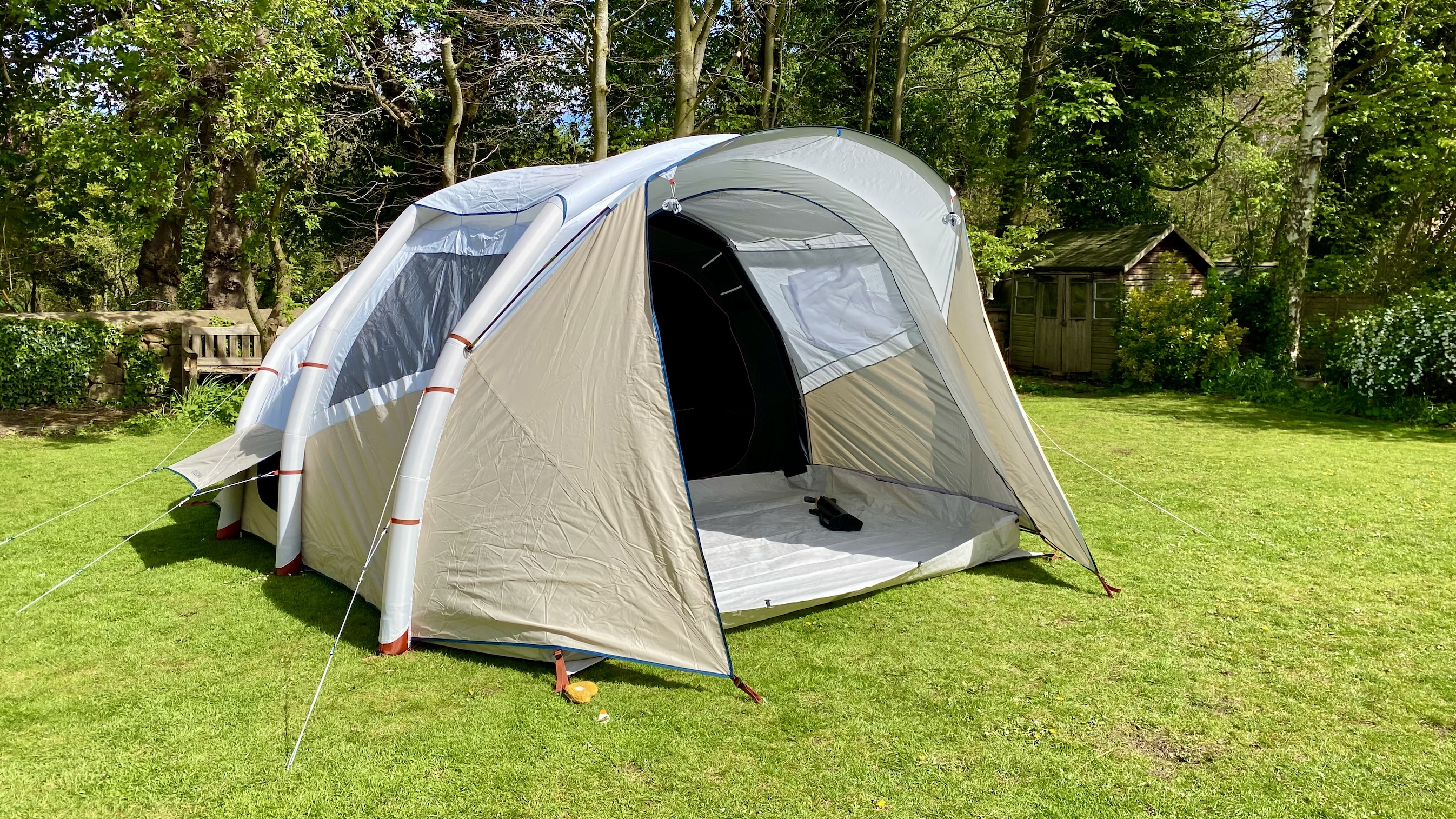
The thing about tent design is that few manufacturers ever manage to combine all the best bits of other tents into one complete unit that covers all bases and most people’s camping requirements. The Air Seconds 5.2 is probably the closest I’ve ever come to what I consider near perfection. It’s superbly designed both inside and out, the materials used are of a very high standard, and its overall build quality is up there with the very best premium tent manufacturers like Berghaus, Coleman, Zempire and Kampa.
Let’s begin with the two-tone livery since that is what attracted me to this handsome model in the first instance. I consider its attractive bright desert sand and snow white colour combination to be a very welcome change from the dark-coloured norm. But there’s a technical reason for this because light colours reflect sunlight while dark colours absorb it.
Hence, when it comes to peak summer sunshine, you will feel much cooler in this tent than you will in a dark one. And that’s not a flippant remark because it genuinely does feel cooler – a lot cooler than my dark green Coleman Air Valdes, for instance.
One of the key things about this tent is that it is inflatable, and I can’t recommend this type of assembly system enough. Yes, it takes a short spell of effort to fill all three of the Air Seconds’ puncture-resistant air beams to the prerequisite 7psi, but it’s about a hundred times easier than setting up a standard pole tent.
Then there’s the quality of the sewn-in Polyethylene ground sheet with adjustable bath-tub entrance to prevent flooding. Where many leisure tent manufacturers opt for a thin crinkly groundsheet, this one feels much thicker than the norm and substantially tough enough to prevent any puncturing or water penetration.
According to the stats, the Quechua’s Polyester flysheet has been lab tested to withstand 200mm of tropical rain per hour while the whole structure has been wind-tunnel tested to Force 7. I put this tent up in a very stiff breeze, and its igloo-shaped design clearly works wonders in the wind because I experienced no flapping, buffeting or swaying – it simply sat stock solid.
You will definitely not be wanting for space when you step inside this tent, that’s for sure. The combined interior living space is a huge 31 square metres and comprises two side-by-side bedrooms and an ample lounging area with a massive full-width portal out onto the wilderness. It’s one of the nicest tents to sit in and admire the views.
At this juncture, I should add that this is not a tent you’ll want to carry a long distance. At 22kgs in weight, it’s easily possible to lug it the short distance between car and pitch, but if you’re wild camping and no cars are allowed on the pitch, you may need to invest in a collapsable trolley or arrange to hire one from the site owner.
Of course, there are numerous other design details with this tent that you will want to know about, so I will cover them in much more detail in the following chapters.
Living space
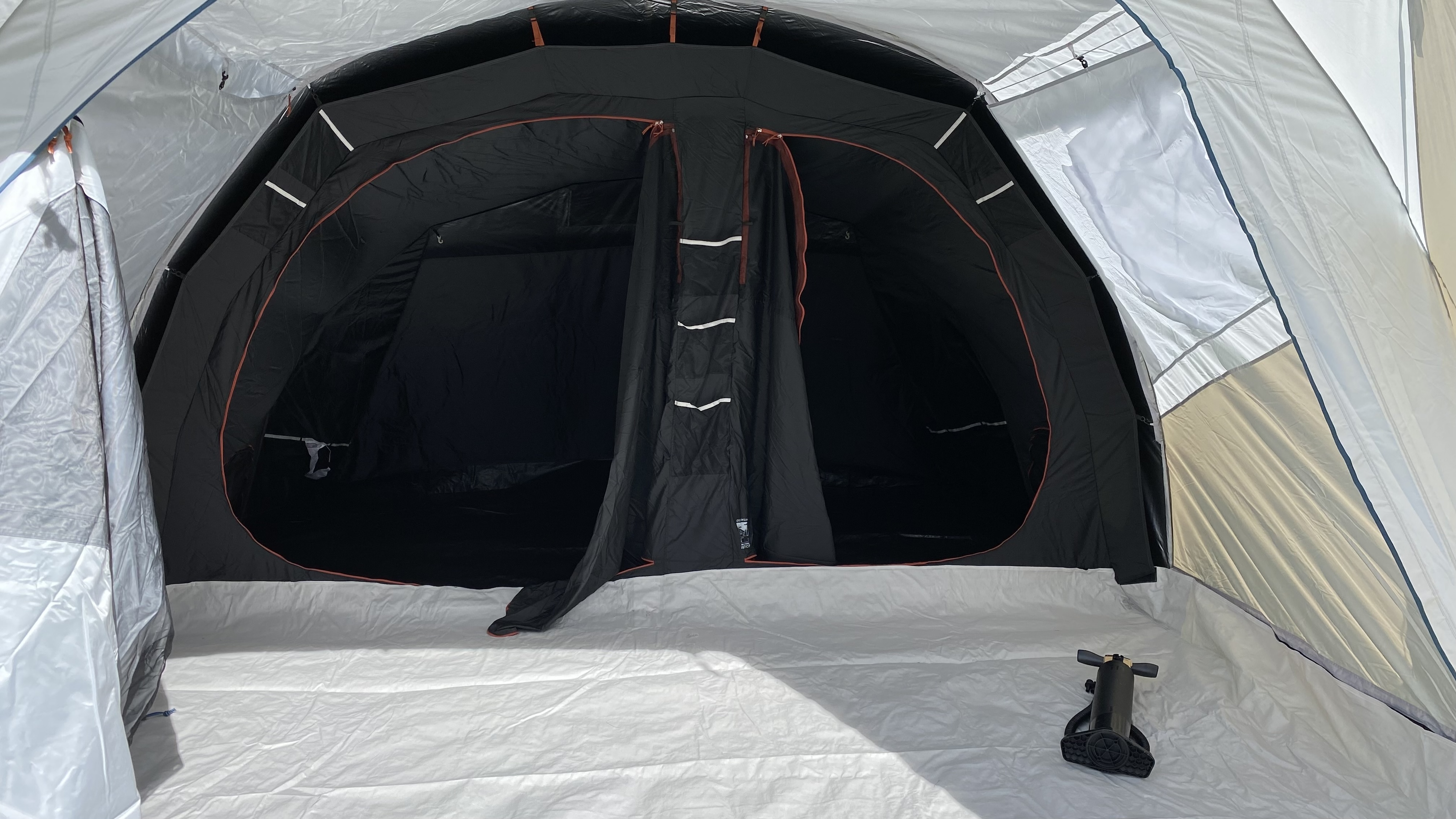
The Quechua’s lounge area is of very decent size – 2.3m x 3.65m x 2.1m – and large enough for a table and two chairs. Granted, there’s no exterior porch area to store your gear but I’ve never been a fan of outdoor porches since they’re always on grass and they always end up looking cluttered once you start storing gear there.
The massive front portal is a major highlight with this tent because it makes the interior feel both amazingly airy and spacious while providing an unobstructed view to the great outdoors. If Grand Designs did tents…
The wide entrance features an internal waterproof lining that can be unzipped from inside to expose the huge mesh window. However, since there is only a small amount of awning above the entrance, I would suggest closing the waterproofed inner lining if going out on a showery day, as there’s a very good chance that rain will enter the tent. I don’t consider this a deal breaker, but it’s something to bear in mind.
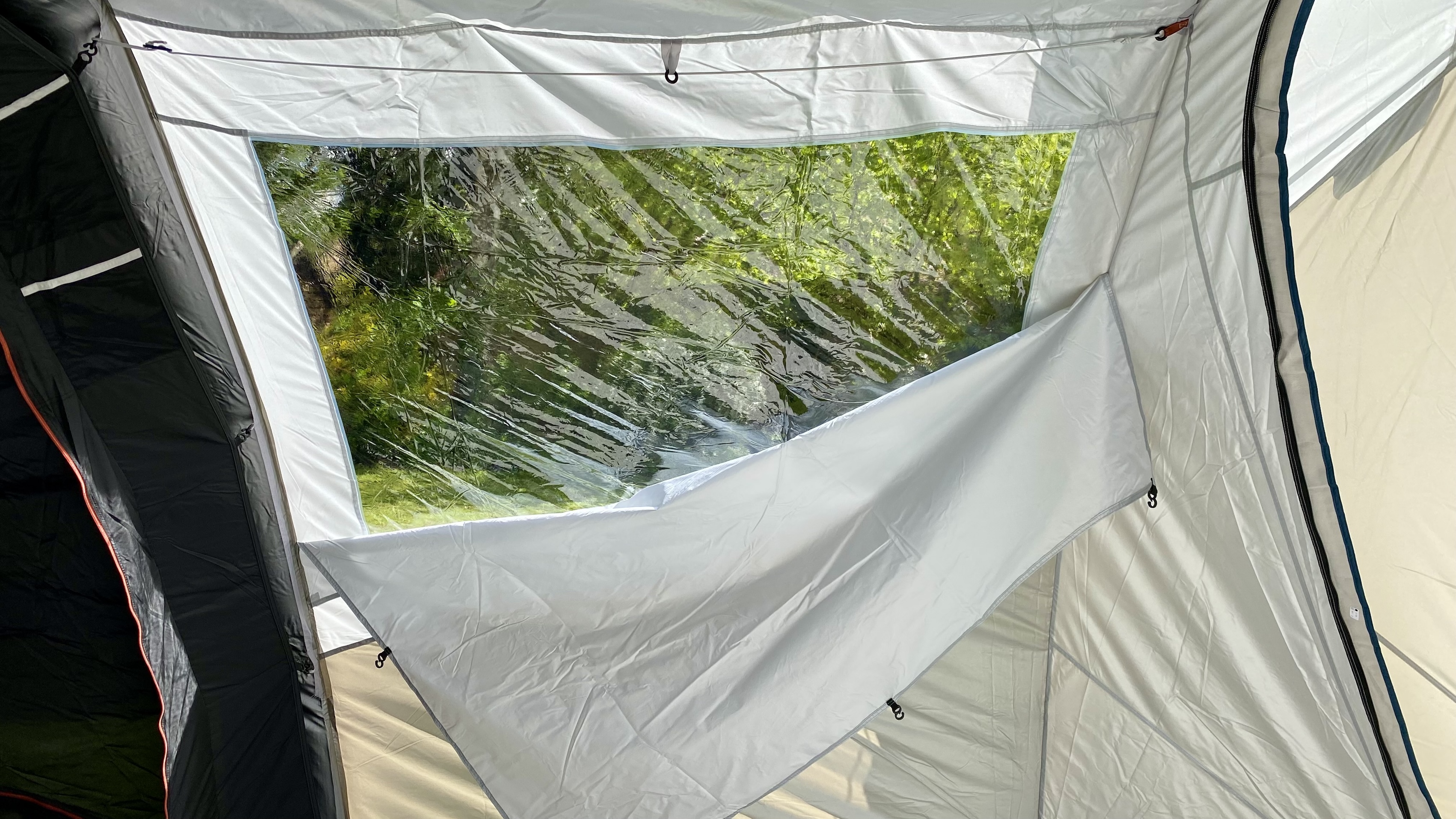
At first, I thought an extra side entrance might have been a handy addition, but on reflection, it would have prevented having space for extra storage. Instead, there’s a mesh window on one side and a plastic window on the other, both with rain protective linings.
However, the unusual design of this tent – specifically the dividing line between its two exterior colours – means that both windows are shaped like a slice of cheese. They look perfectly natural from the outside but a bit odd from the inside, especially with the internal flysheets rolled up at an angle. Mind, I’m nitpicking here because it’s a design element that you’d soon get used to.
Blackout bedrooms
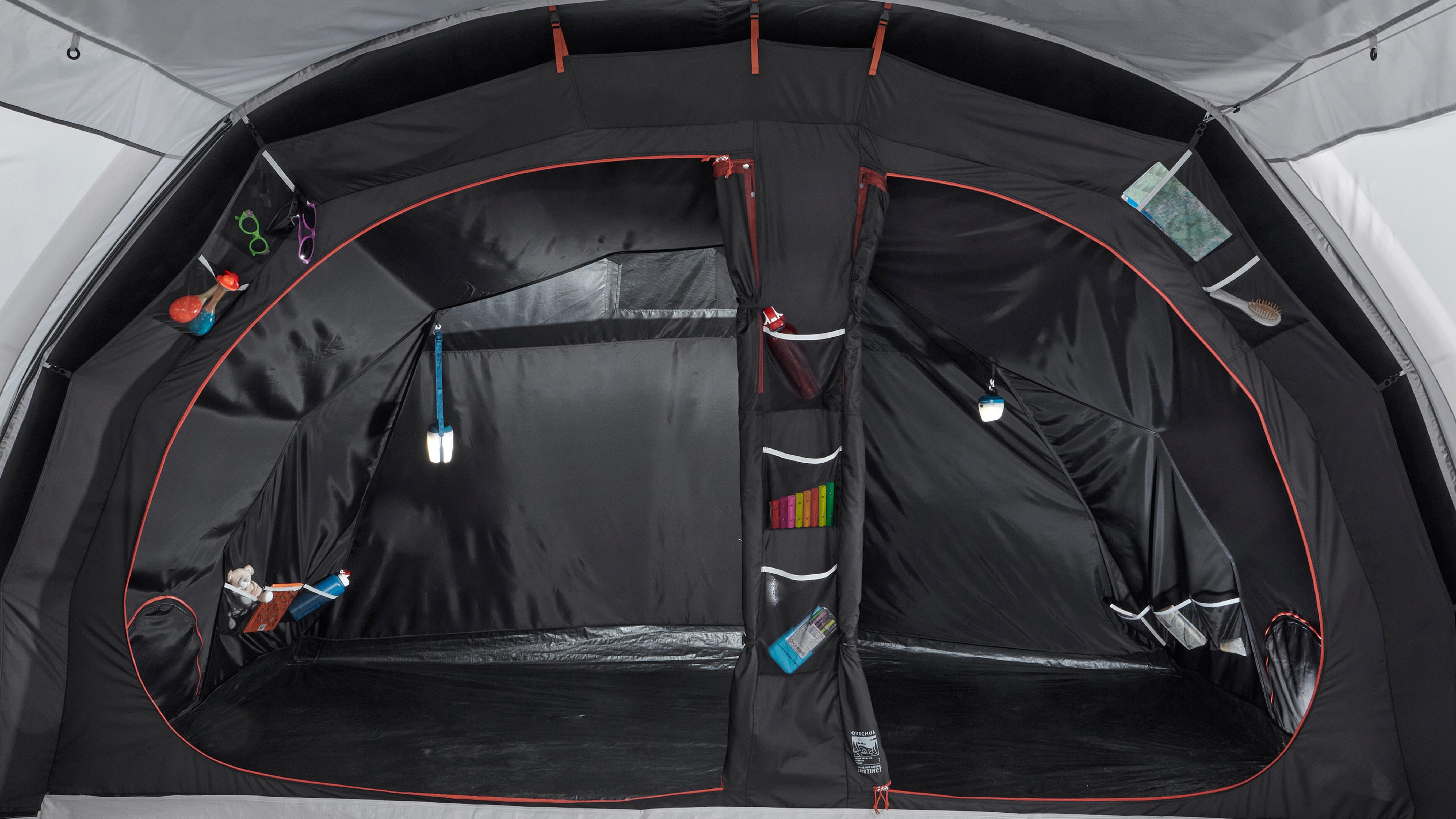
If bedroom space is of prime importance, you’ll be pleased to learn that this model is very well endowed on that front, with a master bedroom measuring 2.10m in width and smaller single room at 1.4m. Both bedrooms are 2.1m in length which is the norm for most tented bedrooms since that is the length of most camping beds.
However, if you remove the fabric partition between the two rooms, you end up with one gargantuan chamber measuring 3.50 metres in width – enough luxurious space for a single couple to place their camping beds in any configuration, plus the addition of side tables and extra space for clothing storage. At 1.8m down to 1.65m, there’s loads of headroom, too, so you can properly stand while you get dressed in privacy.
Like all the best tents, the Quechua Air Seconds 5.2 features blackout bedrooms and I can’t tell you how amazingly innovative this technology is because, as any camper will tell you, as soon as the sun rises (as early as 5am during a European summer), the light penetrates the bedrooms and wakes up all the occupants. As added bonus, the black-out feature also helps when trying to sleep through a typical French lightning storm.
It’s bad enough trying to get some kip with the sound of thunder and the rain pelting against the flysheet but it’s an altogether more scary experience when the whole tent lights up every time there’s a bolt of lightning. This tent’s blackout rooms reduce the effect to some degree.
Another great benefit of blackout bedrooms is that they remain about 5˚C cooler during the day and 1˚C warmer during the night. Of course, if you don’t like the thought of sleeping in total darkness, you can always unzip the top half of the bedroom door with integral ‘no see’ mesh and let a bit of light in.
I should add that not all blackout rooms are created equal. For instance, the blackout rooms in the Vango Beta 550XL CLR I reviewed last year we’re more purple coloured than black. By stark contrast, this tent’s bedrooms are so dark in broad daylight that you can hardly see your hand in front of your face. A good night’s sleep is pretty much guaranteed in this tent.
Ventilation
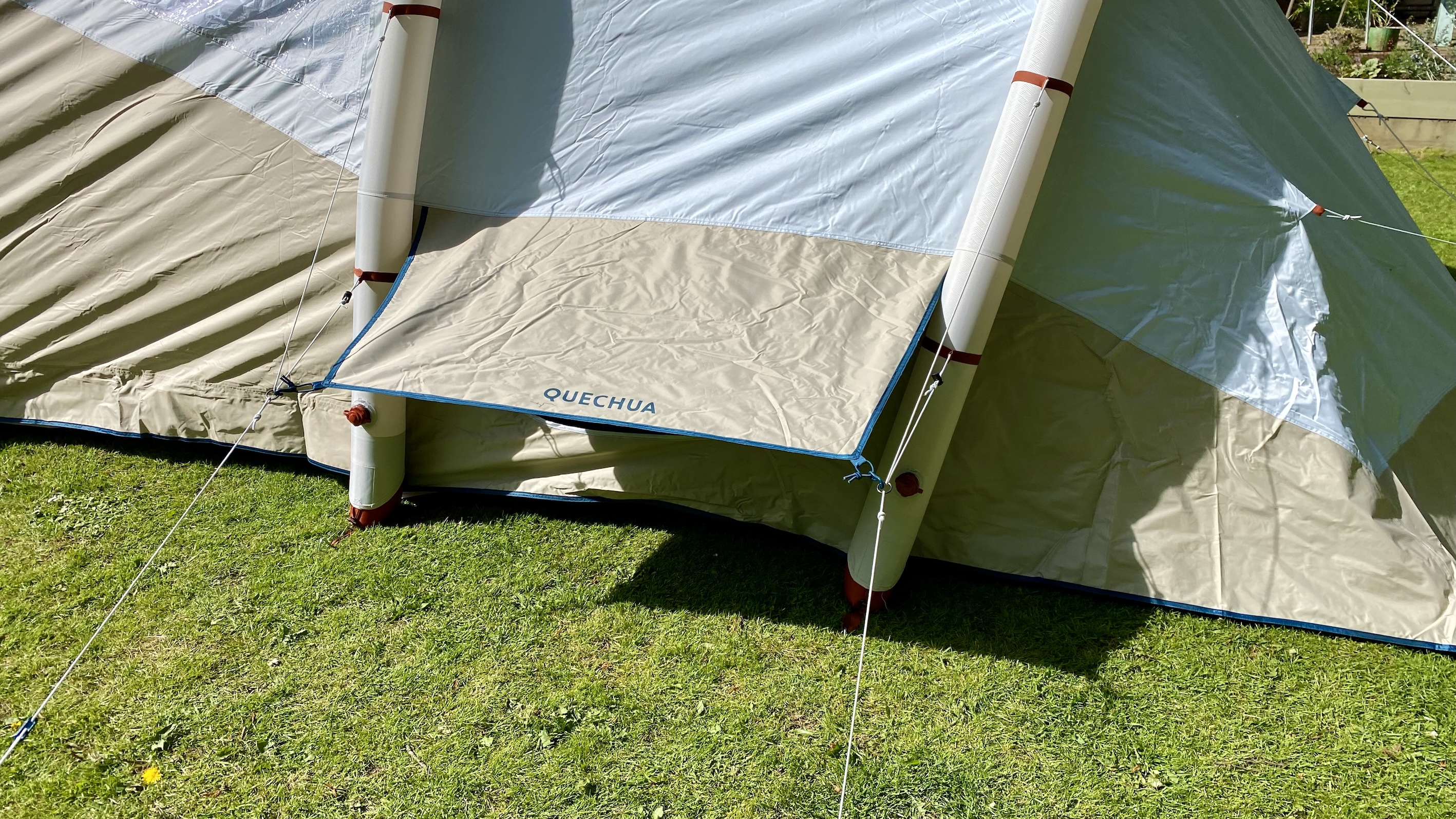
Aside from space to move around and decent waterproofness, ventilation is one of the most important factors in tent design. Without proper ventilation, condensation from breathing and body heat will gather on the inside of the flysheet causing the internal atmosphere to increase in humidity.
Well Quechua has nullified this phenomenon by providing ample ventilation everywhere. Firstly, the ceiling in the lounge has a large mesh opening with a separate flysheet sitting a couple of inches above it. This keeps the living space nice and airy with no sense of dampness.
But it’s even better in the bedrooms where condensation is usually worse. Along with the usual top-mounted ventilation flap near the back of the bedroom, there are also two huge semi-circular air vents at floor level and I can’t stress enough how effective these vents are for helping get a good nights sleep without feeling claustrophobic. If preferred, you could orientate your bed to sleep with your face right near the vent so you can get lungfuls of fresh air.
The vents can be used in two ways – with mesh in place to keep out creepy crawlies or completely open for the full breeze effect. There’s no chance of rain getting in either because both vents are protected by an external flysheet that extends outwards.
But get this… If you’re already in bed and discover it’s suddenly become really nippy, you can either close the vent using the zipper or, for complete closure, reach outside through the open vent and clip the guy ropes holding the flysheet to the bottom of the tent, effectively closing off the ventilation completely. This is just one of so many clever design details with this tent. And there’s more to follow.
Other design details
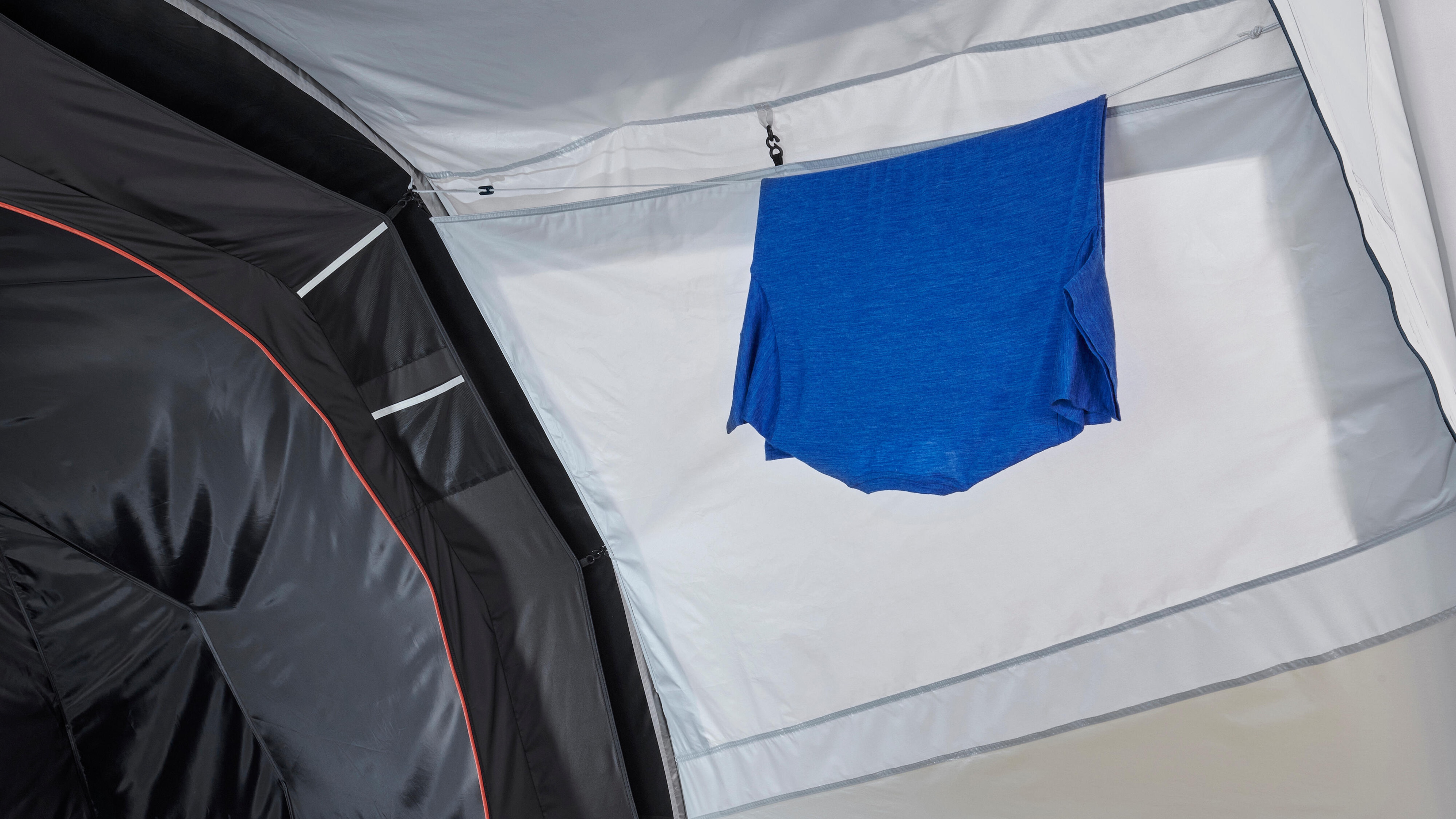
You can tell this tent was designed by campers because, aside for the excellent design details above, there are other brilliant design flourishes everywhere else. Let’s use some bullet points to highlight them all:
- You get a full complement of pegs with this kit, including a few heavy-duty nail-type pegs for harder ground.
- The peg and strut storage bags are padded and tough enough to withstand a thousand years of camping.
- Some of the guy ropes are attached midway to three points on the tent so you don’t end up with too many lines being pegged into the ground.
- The heavy-duty built-in ground sheet has a four-inch lip at the front to prevent rainwater from pouring in. However, it can be unclipped and pegged to lie flat in dry weather for easier access.
- The groundsheet can be unzipped from inside to provide access to the bare ground beneath. This is really handy for removing stones that have a habit of suddenly appearing under your feet.
- There are storage areas everywhere for all your nicknacks. There’s a slim storage net in front of the bedroom with three mesh pockets for holding torches, phones, first aid kits etc, two more on either side of the bedrooms, plus floor pockets on both sides of the bedroom section.
- Hanging clips abound for attaching camping lights, car keys etc.
- In a true flash of inspiration, someone at Quechua thought a built-in interior clothes line might be a handy addition. That person deserves an award!
- The tent bag is oversized because the bods at Quechua know that no mortal can ever pack a tent as well as a factory worker.
Performance
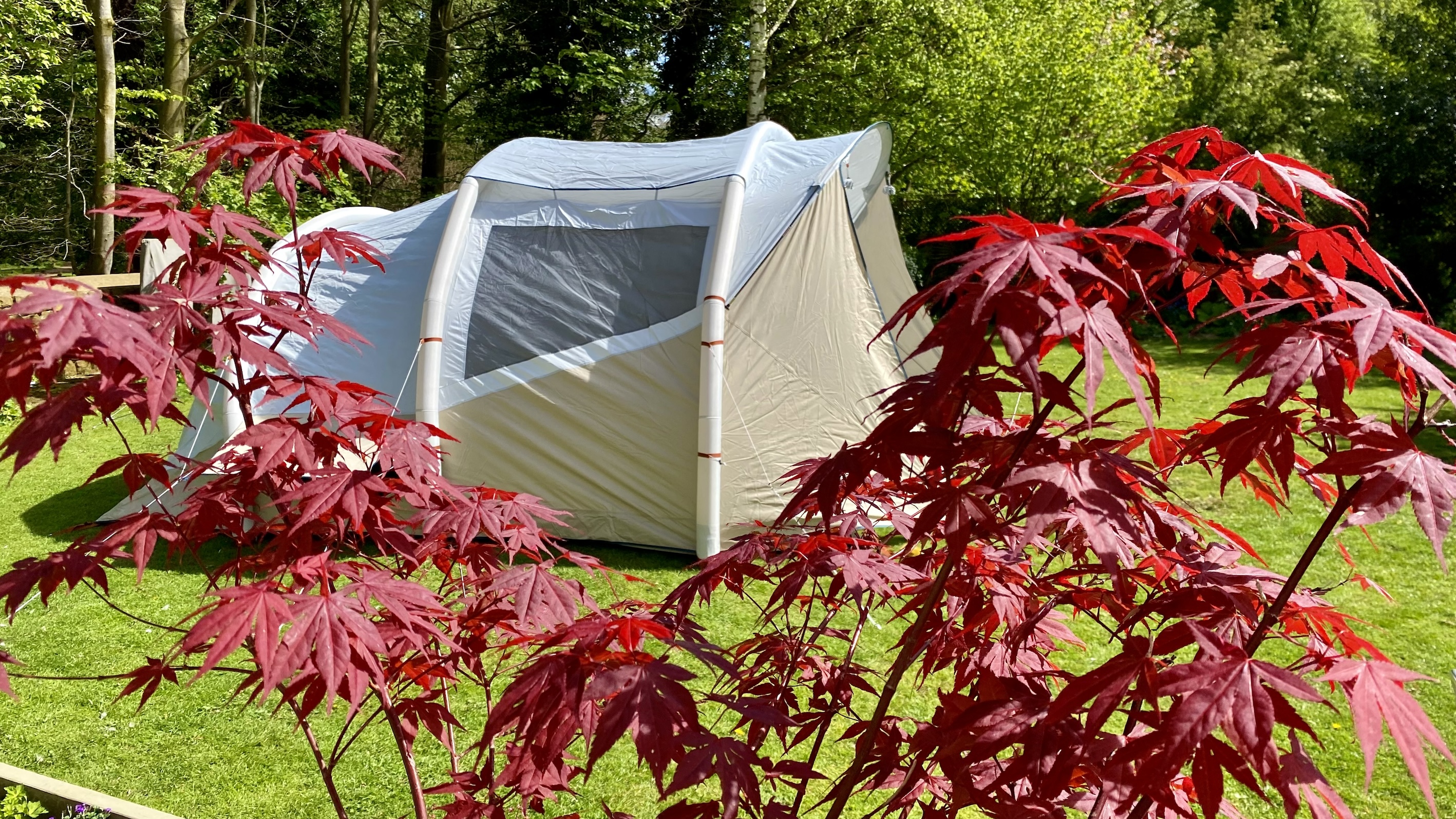
Given the appalling spring weather we’ve recently had in the UK, I had to set up this tent in the garden and sleep overnight in it. And it was amazing. Apart from the occasional sound of barking Muntjac deer and a tawny owl in the distance, we both had a great night’s sleep in this tent and the blackout bedroom made a massive difference come light of dawn.
It was a perfect fit for the Helinox and Quechua camping beds and the similar Inflatable Mattress Comparison features I recently wrote, and I loved all the little design details like floor-level ventilation, side storage pockets and robust groundsheet.
No, it didn’t rain, so I’m unable to report on how well it stood up to a downpour. However, given that it has a hydrostatic head of about 2,000mm—the average for a family tent—I’m confident it will hold up in a French summer downpour.
I frankly can’t wait for summer to come so I can get this beauty out on a proper camping stint in the Peak District. If I have anything new to report, I’ll be sure to let you know.
But in the meantime, I genuinely can’t think of a bad word to say about this tent. It went up with ease, it was comfortably spacious and I can only imagine how amazing the wide threshold will be when positioned facing a stunning vista instead of our garden fence.
Verdict
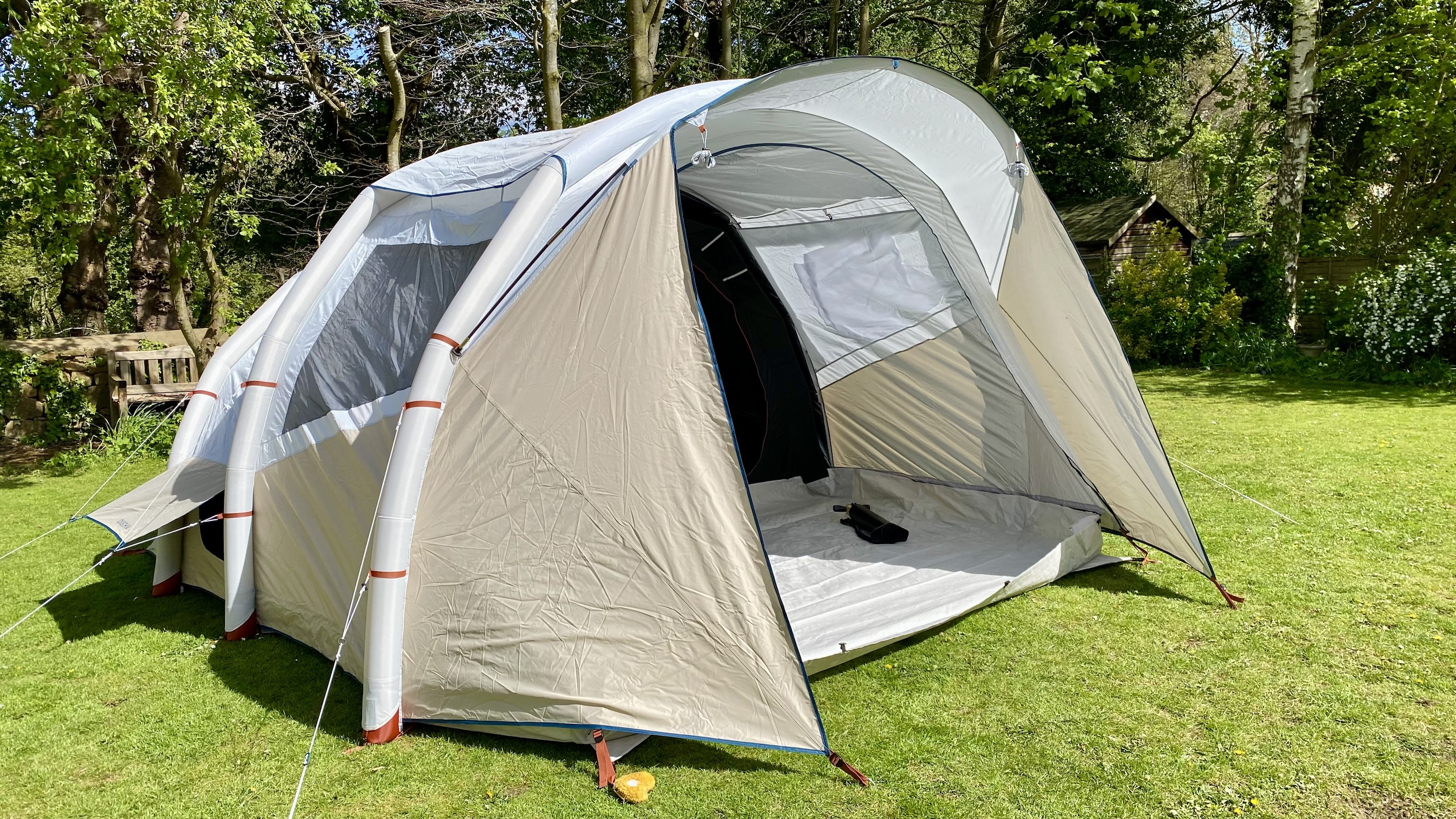
If you’re looking for a sizeable and exceedingly attractive tent that’s been thoughtfully designed to cover every camper’s requirements, this is the model for you. Yes, it’s huge but then again it’s also easy to pitch and take down. And besides, size is everything when camping for more than a few days at a time.
From the moment I pitched it, unzipped the huge front entrance and walked in to discover everything was in position, including the hanging bedrooms and robust groundsheet, I knew this was going to be an easy and thoroughly enjoyable review to write. Top marks all around.







